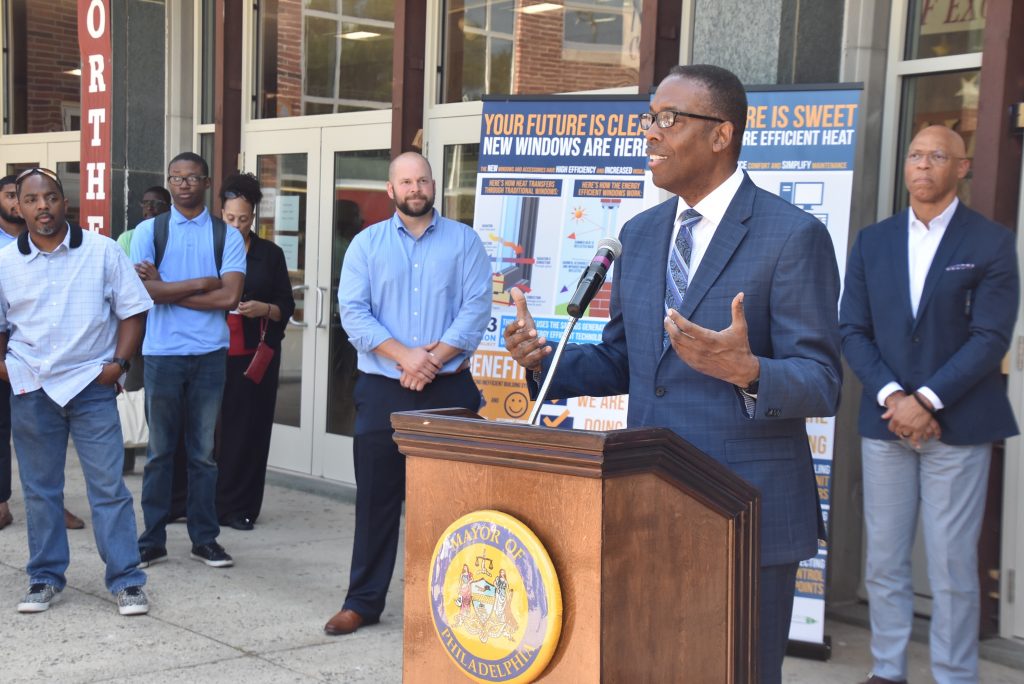The new windows, LED lights and ventilation systems at Northeast High School aren’t the most eye-catching renovations.
However, officials say the school’s energy upgrades have made a real difference. The makeover was part of a $23 million pilot program launched in 2017 to improve energy efficiency at three high schools — Saul, Strawberry Mansion and Northeast.
The changes have cut the schools’ energy bills by 38 percent, and city leaders say the renovations have meant more than just cost savings.
“Students now have a brighter, healthier learning environment because of the crucial renovations made to their classrooms,” Mayor Jim Kenney said during an Aug. 12 news conference at Northeast.
The high school pilot program is part of a larger effort called the Philadelphia Energy Campaign.
Kenney, city officials and representatives from the School District of Philadelphia gathered at Northeast to announce results from the second year of the campaign, which is the Philadelphia Energy Authority’s initiative to invest in energy efficiency and renewable resources.
Northeast, Saul and Strawberry Mansion have saved a combined $375,000 a year on utilities since the improvements were made, said School District Superintendent Dr. William Hite.
“A few years back, the district really began thinking strategically about investments as part of our sustainability initiative,” Hite said. “We needed to make smart decisions that would hopefully result in some significant cost savings and energy efficiency for years to come.”
“This pilot program was such a success that we’re already working with PEA to expand it to quite a few more schools,” he added.
At Northeast, 1950s-era single-pane windows were replaced with sturdier windows that reflect sunlight and keep out the heat, said Steve Chausse, who works for NORESCO, which was hired by the city to do the project.
In addition, classroom lights are now equipped with sensors, which can detect sunshine and whether the room is unoccupied.
“There are comfort level and aesthetic values that are incalculable,” School District engineer Craig Harnitchek said in the campaign’s annual report, which was released at the news conference. “The community will see new windows and doors on the property that improve the appearance of the school.”

Savings from the program will be redirected to help pay for capital improvements at the schools, such as new boilers. The School District spends $40 million a year on utilities, according to a PEA report.
PEA, a city agency that promotes energy affordability and sustainability, has helped invest $101 million in energy projects and created nearly 1,000 jobs since the campaign started in 2016, according to Emily Schapira, the agency’s executive director.
Schapira said the campaign is on track to hit its goal of creating 10,000 jobs in the industry by 2026.
Elected officials and city leaders also touted other parts of the campaign, including a water and sewer line insurance plan and a solar energy job training program for high school students.
They painted the city as a national leader in energy efficiency and renewable energy, especially solar power.
“This is moving us to another level,” City Council President Darrell Clarke said.
Those in attendance included 10th District Councilman Brian O’Neill, Councilman At-Large Derek Green, Councilwoman At-Large Blondell Reynolds Brown and Philadelphia Federation of Teachers President Jerry Jordan.
The event served as a kickoff to the city’s Solar Week. Last Wednesday, Kenney signed a bill creating a rebate program as an incentive for residents to switch to solar energy.
For more information on PEA’s energy programs, visit www.philaenergy.org. ••






